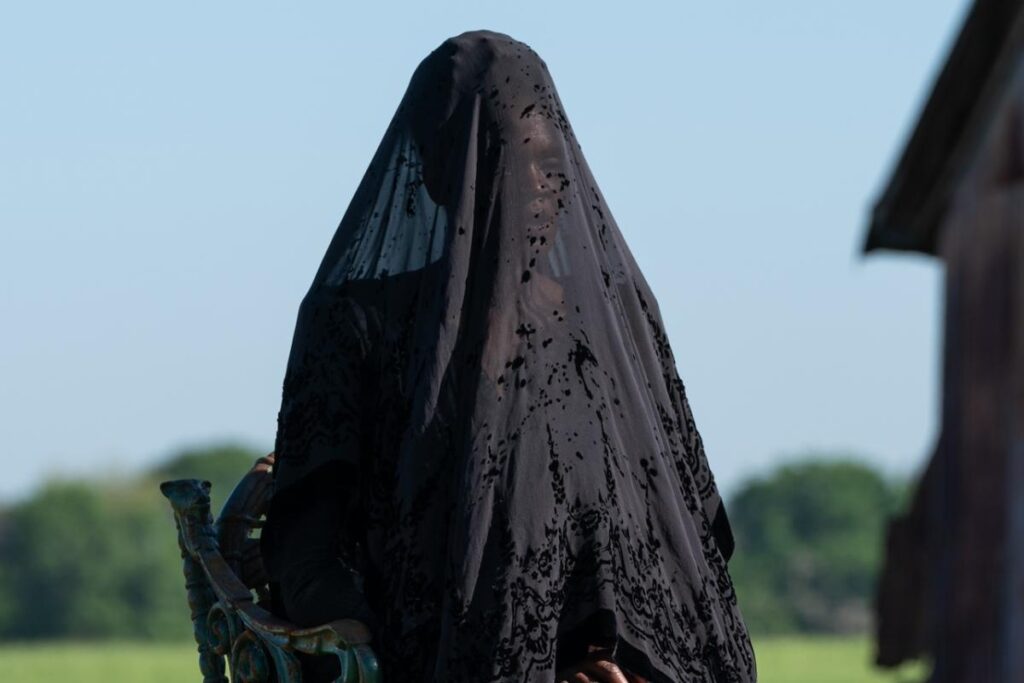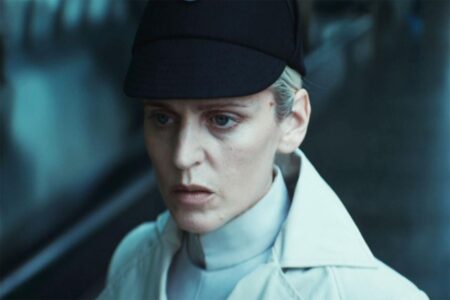For such an intimately scaled movie – one basic location; basically five on-screen characters of any consequence – The Woman in the Yard is capable of generating a lot of debate. Jaume Collet-Serra’s recent horror movie, following just months after his Netflix hit Carry-On, has a simple, mysterious premise: Ramona (Danielle Deadwyler) and her kids Taylor (Peyton Jackson) and Annie (Estella Kahiha) notice a woman, veiled in black, sitting on the lawn of their farmhouse property. What is she doing there and what does she want? That’s the question that drives the slow-building creepiness of the movie, which Collet-Serra directs the hell out of, using a variety of visually arresting techniques to disorient and disturb the audience alongside Ramona and her family. The ultimate answer is clear, but what happens after the movie answers that question is less so. As always, Decider is here to help untangle the psychological knots, so let’s explain our take on the ending of The Woman in the Yard. Heavy spoilers abound.
The Woman in the Yard plot summary
There isn’t a lot of plot, per se, in The Woman in the Yard; it’s more like festering backstory. We learn early in the film that Ramona is reeling from the loss of her husband David (Russell Hornsby), father to her children, who is seen in a few flashbacks. He recently died in a car crash – the wrecked car is, strangely and symbolically, still sitting in their front yard – that Ramona survived, so there’s more than a bit of guilt weighing her down, too, which will come into play a little later. When Ramona wakes up to face another day, we see that she’s struggling to be a good mom to her kids; the power has gone out at their farmhouse, and no one can call the power company because Ramona let her phone battery drain to zero. Taylor does his best to help around the house, but he’s a teenager, and not well-equipped to serve as a substitute parent, especially to a short-fused mother, who snaps at Annie, her young daughter, for repeatedly writing her “R”s backwards (and snaps at Taylor for, well, being kind of an annoying teenager). When the shrouded woman (Okwui Okpokwasili) shows up in their yard, Taylor is frustrated by his mother’s inability to do anything about it.
As the day goes on, the woman moves closer to the house, and it becomes clear that she holds some kind of power over the shadows that ended from her. She refuses to answer any questions directly, simply telling Ramona that “today’s the day.” Eventually, the shadowy powers and the woman herself invade the house, and it becomes clear that she knows the truth about David’s death: It was Ramona at the wheel, not David, and it followed an argument about Ramon’s depression and dissatisfaction with their life on the farm. As the woman invades the space of the home, Ramona starts experiencing more fantastical changes, like vivid hallucinations and eventually a “mirror world” where she is able to relive a moment with David (or an image of him).
Basically, the farmhouse winds up haunted by Ramona’s own personal tumult. It becomes clear that she has unconsciously summoned the woman in the yard; she is a physical manifestation of Ramona’s clinical depression, which dates much further back than grief over losing David. Though Ramona claims to have been praying for the strength to get through the loss of her husband, the woman claims (seemingly correctly) that she was truly praying for the strength to end her own life. In the mirror world, the woman shows Ramona pictures of Taylor and Annie growing up, happy and healthy without their mother, who the woman says will only be a burden to them if she says alive. As night falls, Ramona (who has also experienced disturbing visions of harming her children) agrees that “today’s the day.” She sends the children away, takes a rifle into the barn, and sits there in solitude. What happens next is up for some debate.
The Woman in the Yard ending explained
Though Collet-Serra cuts to an exterior shot of the barn, priming us to expect a shot to ring out, we don’t hear anything. Instead, Taylor and Annie return, and Ramona emerges from the barn, seemingly back from the brink of her suicidal ideation. The woman has disappeared, and the kids ask whether she’ll be back. Ramona says that if the woman returns, she’ll be ready, and the family returns to their home together, implying that Ramona is determined to treat her illness.
However, a few things feel slightly amiss as this ending unfolds. One is that their home now has a sign with a name for their modest estate, something David and Ramona had discussed before his death. Another is that the house seems to be fully fixed up and in good repair; its halfway state was a point of contention between David and Ramona, as well as commented upon earlier that morning as a project now facing Ramona in the midst of her grief. Finally, the camera pushes in on one of Ramona’s paintings, which has an image of both herself and the woman. It’s also signed with Ramona’s name, using a backwards “R.”
It would be easy enough to interpret this as a sign that Ramona has entered a kind of mirror-world purgatory, easing her way into the afterlife after she did, indeed, follow through with her suicide; the house looks more idyllic than it had before, and part of her signature is backwards. Yet there are ambiguities in these images, too. Earlier, our glimpse of the mirror world included David; if this is a vision designed to placate Ramona, why would her husband still be dead? The painting, too, seems like a note of optimism; earlier in the film, we see Ramon’s artwork and it appears to be dominated by a shrouded figure like the woman. A painting that more clearly depicts Ramona herself, coexisting with the woman, seems like a reconciliation of her depression with the rest of herself, and her desire to live. The fixed-up house could be a smoothly integrated flash forward to a happier time; Collet-Serra uses all kinds of visual tricks in the movie to bleed together the past and present, and it wouldn’t be out of line for him to do that again, now depicting a happy ending.
Yet there is something that feels not quite real about this happiness and, indeed, a truly settled flash forward to Ramona finding the will to live might not focus so intently on that backwards “R.” (Though, again, that was something her daughter was doing, and could also be an homage to her or to her experiences on this day.) Ultimately, the film is ambiguous, fitting in with the ambiguity of how, exactly, this woman who is depression personified was even visible to Ramona’s kids. What actually happened in the physical world? The movie doesn’t really say.
In some ways, all of this feels like a cheat: a vague solution for a movie that doesn’t want to provide an unrealistically pat ending to a story about someone with severe clinical depression, but also doesn’t want to alienate its audience with an unbearably bleak finale. On the other hand, this dodge may be the film’s only satisfying path out of the hell Collet-Serra so expertly builds in Ramon’s head. Either bleakness or triumph would both feel pretty predictable; they could both, in fact, feel insulting in their own way. Instead, The Woman in the Yard forces its audience to live with the capacity for great relief and crushing sadness; even if it’s a little craven, it’s true to its tricky, audacious treatment of delicate subject matter. With so many horror movies content to offer easy “the monster is grief” metaphors, Collet-Serra has made a movie that’s more challenging.
Jesse Hassenger (@rockmarooned) is a writer living in Brooklyn podcasting at www.sportsalcohol.com. He’s a regular contributor to The A.V. Club, Polygon, and The Week, among others.
Read the full article here








